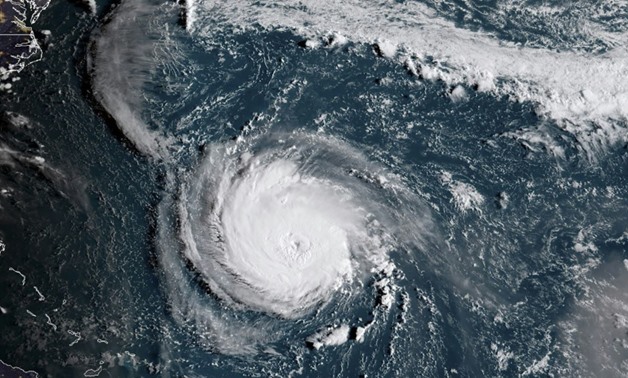
This NOAA/RAMMB satellite image shows Hurricane Florence off the US East Coast in the Atantic Ocean
CALIFORNIA - 12 September 2018: Hurricane Florence would deliver a "direct hit" to the US East Coast, emergency officials warned on Tuesday, urging residents to heed evacuation orders and seek shelter from the potentially catastrophic storm.
More than one million people in North Carolina, South Carolina and Virginia have been told to flee their homes as the hurricane churns across the Atlantic Ocean towards the coast.
The Miami-based National Hurricane Center (NHC) said that Florence remained a Category 4 hurricane as of 11:00 am (1500 GMT) packing deadly winds of 130 miles per hour (215 kilometers per hour).
"This storm is not going to be a glancing blow," said Jeff Byard, associate administrator for response and recovery at the Federal Emergency Management Agency (FEMA).
"This storm is going to be a direct hit," Byard told a press conference in Washington, warning of the potential for massive damage, flooding, power outages and loss of life.
Urging residents to evacuate, Byard said Florence was "the strongest storm to target the Carolinas and this part of the country in decades."
The NHC said Florence is expected to begin "re-strengthening later today and continue a slow strengthening trend for the next day or so."
It said Florence is expected to be an "extremely dangerous major hurricane" when it makes landfall in the Carolinas on Thursday, bringing life-threatening storm surge to coastal areas.
A state of emergency has been declared in Maryland, North Carolina, South Carolina, Virginia and Washington amid concern over potential torrential rain and flooding.
Washington Mayor Muriel Bowser said the emergency was "effective immediately" and "ensures that we will have the resources we need to prepare."
The last time the US capital declared a state of emergency was in January 2016 when a winter storm dubbed "Snowzilla" blanketed the capital region in knee-deep snow.
- 'Bring a pillow and a blanket' -
In Charleston, South Carolina, residents were making preparations to leave Tuesday while others planned to ride out the storm.
Streets were quiet with schools and many offices and businesses closed.
Michael Kennedy, an engineer at Boeing, said he planned to leave on Tuesday for his parents' home in Atlanta, Georgia.
But his partner, Emily Whisler, said she will remain behind at the university where she is a resident in the psychiatry program.
"They told me to bring a pillow and blanket," Whisler said over breakfast at Brown's Court Bakery. "I'll be living there for a few days."
Whisler, who is from California, said this is her first hurricane and friends and family from the West Coast have peppered her with their concerns during the last 24 hours.
"I have had 10 people text me, worried about whether I'm staying or evacuating," she said.
Tyler Szekalski said he and his girlfriend live in a fourth-floor apartment and were planning on staying put with their dog Moose.
He said they purchased a few supplies in preparation. "Just a bunch of groceries, water, gas in the truck," said Szekalski, an assistant project manager with Mashburn Construction.
South Carolina Governor Henry McMaster on Monday ordered the mandatory evacuation of one million coastal residents. Schools in 26 of the state's 46 counties were ordered closed from Tuesday.
The governor of neighboring North Carolina ordered an evacuation of the Outer Banks, barrier islands that are a popular tourist destination, and parts of coastal Dare County.
In Virginia, 245,000 coastal residents were ordered to evacuate by 8:00 am Tuesday including from the Eastern Shore, another popular beachfront getaway destination.
"Hurricane Florence has the potential to cause catastrophic flooding, especially in our coastal areas," Virginia Governor Ralph Northam said, activating the National Guard.
In neighboring Maryland, Governor Larry Hogan said his state was readying for potentially "historic and catastrophic rainfall, life-threatening flooding, and high winds."
- 'Be SAFE!' -
"This is one of the worst storms to hit the East Coast in many years," President Donald Trump warned on Twitter. "Please be prepared, be careful and be SAFE!"
Trump approved emergency declarations for the Carolinas, a standard move allowing the release of federal funds and equipment to aid in protection and recovery efforts.
On the five-level Saffir-Simpson hurricane wind scale Florence is a Category 4, meaning it is capable of causing "catastrophic damage."
At 1500 GMT, Florence was 390 miles (625 kilometers) south of Bermuda moving west-northwest on a path directly towards the Carolinas at 16 mph (26 kph).
By Saturday, total rainfall could accumulate to 20 inches (51 centimeters) -- or even 30 inches in places -- in parts of the Carolinas and Virginia, the NHC said.
The US Navy was sending about 30 ships stationed at its major bases in Virginia out to sea.
The vessels would get underway from Naval Station Norfolk and Joint Expeditionary Base Little Creek to avoid potential damage from winds and tidal surges, said Colonel Rob Manning, a Pentagon spokesman.
At this height of the Atlantic hurricane season, Florence was being trailed on east-to-west paths by two other storms, Hurricane Helene and Tropical Storm Isaac, but neither packs the deadly punch of Florence.

Comments
Leave a Comment